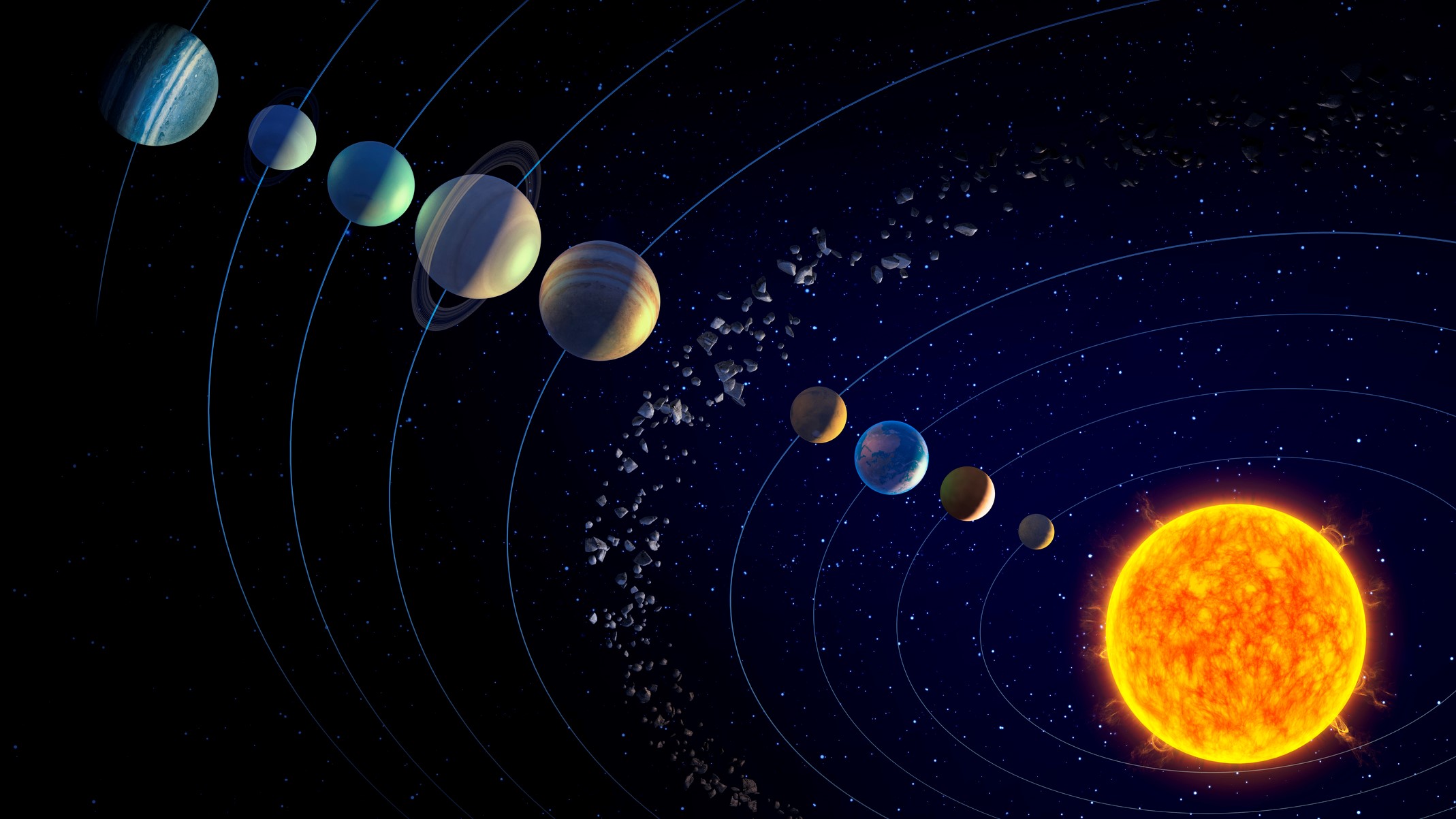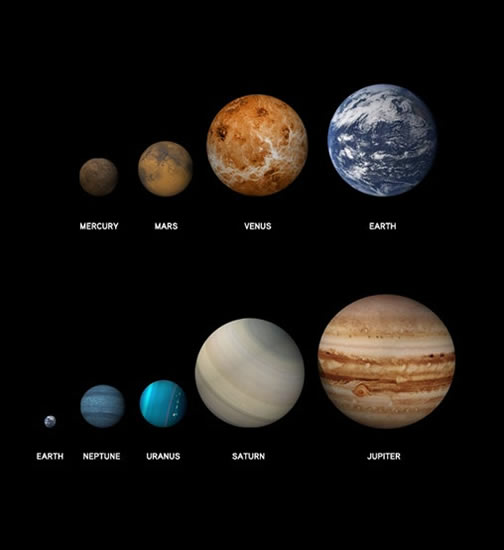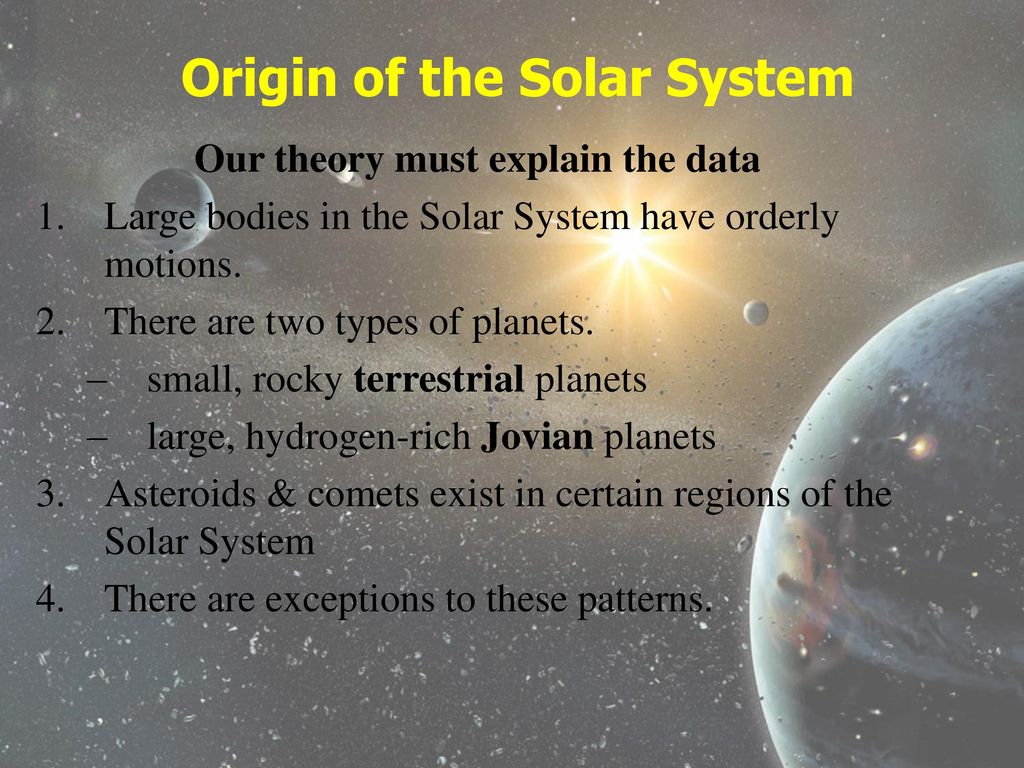Describe the Origin of the Planets
Solar radiation causes ice to evaporate on the sunward side of the nucleus. Take an interactive tour of the solar system or browse the site to find fascinating information facts and data about our planets the solar system and beyond.
The planets orbit in nearly the same plane.

. The History of an Idea That Launched the Scientific Revolution. The planets that have been found are very large and orbit too near the stars to fit the secular expectations. Comets travel in regular orbits their motions dominated by the gravity of the sun and the major planets but other forces can come into play.
Molecules released by the evaporation stream away from the comet and generate a jet-type reaction that pushes the comet away. All of the planets orbit in the same direction as the Sun spins. The book begins with a historical review of four major theories for the origin of the Solar System in particular or of planets in general which highlight the major problems that need to be solved by any plausible theory.
In addition to discovering the planet Uranus he also observed and cataloged over 800 double stars and 2500 nebulae. There are eight planets in the solar system. Origin of the solar system.
In the ancient world theories of the origin of Earth and the objects seen in the sky were certainly much less constrained by fact. They rotate through the sky over the seasons so unchangingly that most cultures have used the presence of one or another constellation to tell time. In the outer solar system where it has always been cooler the planets and their moons as well as icy dwarf planets and comets are composed mostly of ice and gas.
These planets have a slower orbit than the inner planets and as such affect a larger group of people. The current count orbiting our star. The four inner terrestrial planets are Mercury Venus Earth and Mars all of which consist mainly of rock.
Describe a few features of Jupiters magnetosphere and compare it to the magnetospheres of the other jovian planets. Explain the differences between oceanic and continental crust. The extrasolar planets discovered so far do not fit the nebular hypothesis of planet formation.
The outer planets Uranus Neptune and Pluto are considered the generational planets. The planets located close to the stars are supposed to be small rocky planets according to the evolutionary model. As the amount of data on the planets moons comets and asteroids has grown so too have the problems faced by astronomers in forming theories of the origin of the solar system.
In many theories including that which form the major theme of this book the formation of. The four outer planets are Jupiter Saturn Neptune and Uranus giant planets that consist mainly of either gases or ice. The social planets link us to the world by influencing our belief systems sense of expansion and philosophy.
The planets however are different puzzling. Observed features any origin model of the solar systemplanets must explain 1. Identify the names and composition of the various layers of the Earth.
Inner terrestrial planets are high density Jovian outer planets are low density. In the black dome of night the stars seem fixed in their patterns. Recall the age of the universe the solar system and Earth.
A second approach to understanding the origins of the solar system is to look outward for evidence that other systems of planets are forming elsewhere. Indeed a scientific approach to the origin of the. In the dynamicist definition adopted by the International Astronomical Union IAU a planet is a non-stellar body that is massive enough to be rounded by its own gravity that directly orbits a star and that has cleared its orbital zone of.
Almost all the planets spin on their axes in the same direction as the Sun spins. On the Origin of Planets. For most planets direction of motion and orbit are same note peculiarities of Venus Uranus Pluto however 4.
Almost all planetary orbits are nearly circular. The planetary system is highly differentiated. There are more planets than stars in our galaxy.
Herschel was probably the most famous astronomer of the 18th century. The Nine Planets has been online since 1994 and was one of the first multimedia websites that appeared on the World Wide Web. After reading this chapter you should be able to.
Explain the processes responsible for the early formation of Earth. He was the first astronomer to correctly describe the spiral structure of our Milky Way Galaxy. Uranus was discovered by Sir William Herschel in 1781.
The inner rocky planets are Mercury Venus Earth and MarsNASAs newest rover Perseverance landed on Mars on Feb. Pluto was considered the ninth planet until 2006 when the. Orbits in same plane 3.
A planet is a large astronomical body that is neither a star nor a stellar remnantThere are competing scientific definitions of a planet. The outer planets are gas giants Jupiter and Saturn and ice giants Uranus and Neptune. Beyond Neptune a newer class of smaller worlds called dwarf.
The Evidence from Far Away. The global magnetic field and Jupiters rapid rotation It traps far more charged particles than Earths - Io contributes many additional particles They create auroras and belts of intense radiation.

Solar System Simple English Wikipedia The Free Encyclopedia

Origin Of Our Solar System Tek Objective 5 Earth In Space And Time The Student Understands The Solar Nebular Accretion Solar System Solar System Model Solar

Solar System Planets Order And Formation A Guide Space

How Our Solar System Formed Article Khan Academy

How Did The Solar System Form Space

The Origin Of The Solar System Ppt Download

Tilt Of Moon S Axis May Explain The Origin Of Water On Earth Earth And Space Science Earth Science Earth

Any Theory About The Origin Of The Solar System Must Explain Why All Of The Planets Orbits Lie More Or Less In A Plane And All Of The Planets Orbit The

Solar System And Planets Powerpoint Solar System Planets Graphic Organizers

No comments for "Describe the Origin of the Planets"
Post a Comment